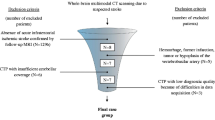Abstract
320-row CT enables dynamic CT angiography (4D CTA) of the entire intracranial circulation and whole-brain perfusion imaging (CTP). Sixty acute patients with neurological symptoms underwent various 320-row CT-specific protocols, including combined 4D CTA and CTP. Clinical and neuroradiological records were assessed for presumptive diagnoses, final diagnoses, supplementary and follow-up imaging studies. Additional diagnostic benefits delivered by 320-row CT were noted. Out of 60 procedures, 59 were accomplished successfully. Ischemia (n = 19), intracerebral hemorrhage (n = 7) and transient ischemic attacks (n = 10) were the major final diagnoses. Except one small cortical and two small subcortical infarctions all ischemias were diagnosed. All hemorrhages were diagnosed together with their underlying vascular pathology in five atypical cases. In conclusion, 320-row CT is a technically robust procedure being suitable for comprehensive neuroimaging of acute patients. It can provide dynamic angiographic and perfusion data of the whole brain and can deliver additional diagnostic information not available by standard CT.






Similar content being viewed by others
References
Klingebiel R, Busch M, Bohner G, Zimmer C, Hoffmann O, Masuhr F (2002) Multi-slice CT angiography in the evaluation of patients with acute cerebrovascular disease–a promising new diagnostic tool. J Neurol 249(1):43–49
Klingebiel R, Siebert E, Diekmann S, Wiener E, Masuhr F, Wagner M, Bauknecht H, Dewey M, Bohner G (2009) 4-D imaging in cerebrovascular disorders by using 320-slice CT: feasibility and preliminary clinical experience. Acad Radiol 16(2):123–129
Wintermark M (2005) Brain perfusion-CT in acute stroke patients. Eur Radiol 15(Suppl 4):D28–D31
Tan JC, Dillon WP, Liu S, Adler F, Smith WS, Wintermark M (2007) Systematic comparison of perfusion-CT and CT-angiography in acute stroke patients. Ann Neurol 61(6):533–543
Youn SW, Kim JH, Weon YC, Kim SH, Han MK, Bae HJ (2008) Perfusion CT of the brain using 40-mm-wide detector and toggling table technique for initial imaging of acute stroke. Am J Roentgenol 191(3):W120–W126
Schramm P, Schellinger PD, Klotz E, Kallenberg K, Fiebach JB, Külkens S, Heiland S, Knauth M, Sartor K (2004) Comparison of perfusion computed tomography and computed tomography angiography source images with perfusion-weighted imaging and diffusion-weighted imaging in patients with acute stroke of less than 6 hours’ duration. Stroke 35(7):1652–1658
Siebert E, Bohner G, Dewey M, Masuhr F, Hoffmann KT, Mews J, Engelken F, Bauknecht HC, Diekmann S, Klingebiel R (2009) 320-slice CT neuroimaging: initial clinical experience and image quality evaluation. Br J Radiol 82(979):561–570
Rajajee V, Kidwell C, Starkman S, Ovbiagele B, Alger J, Villablanca P, Saver JL (2008) Diagnosis of lacunar infarcts within 6 hours of onset by clinical and CT criteria versus MRI. J Neuroimaging 18(1):66–72
Casey SO, Alberico RA, Patel M, Jimenez JM, Ozsvath RR, Maguire WM, Taylor ML (1996) Cerebral CT venography. Radiology 198(1):163–170
Klingebiel R, Bauknecht HC, Bohner G, Kirsch R, Berger J, Masuhr F (2007) Comparative evaluation of 2D time-of-flight and 3D elliptic centric contrast-enhanced MR venography in patients with presumptive cerebral venous and sinus thrombosis. Eur J Neurol 14(2):139–143
Boukobza M, Crassard I, Bousser MG, Chabriat H (2009) MR imaging features of isolated cortical vein thrombosis: diagnosis and follow-up. AJNR Am J Neuroradiol 30(2):344–348
Cohnen M, Wittsack HJ, Assadi S, Muskalla K, Ringelstein A, Poll LW, Saleh A, Mödder U (2006) Radiation exposure of patients in comprehensive computed tomography of the head in acute stroke. AJNR Am J Neuroradiol 27(8):1741–1745
Author information
Authors and Affiliations
Corresponding author
Additional information
E. Siebert and G. Bohner contributed equally to this work.
Rights and permissions
About this article
Cite this article
Siebert, E., Bohner, G., Masuhr, F. et al. Neuroimaging by 320-row CT: is there a diagnostic benefit or is it just another scanner? A retrospective evaluation of 60 consecutive acute neurological patients. Neurol Sci 31, 585–593 (2010). https://doi.org/10.1007/s10072-010-0292-7
Received:
Accepted:
Published:
Issue Date:
DOI: https://doi.org/10.1007/s10072-010-0292-7




